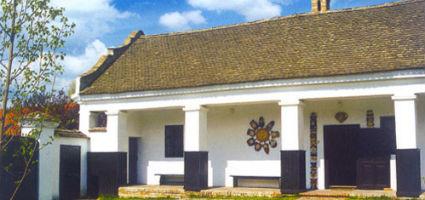2024. April 29. Monday
Fairy Tale House - Békéscsaba
 |
Address: 5600, Békéscsaba Békési út 17.
Phone number: (66) 326-370
E-mail: mesehaz@mesehaz.hu
Opening hours: Mon-Fri 9-16
At the weekends and in the evening we are open if a program is on The museum is closed during the holidays. |
The exhibition has closed for visitors.
2015.06.06. - 2015.07.31.
Museum tickets, service costs:
|
Ticket for adults
|
200 HUF
|
|
|
Ticket for students
|
100 HUF
|
The theme of the exhibition has been always today to the people as sick people, illness, miraculous healing has always been and probably will be too.
Folk medicine is part of intellectual culture, it reflects the typical self-healing process of the peasant way of life, the perception of rural people about disease and remedies. Our exhibition focuses on folk oriented approach taking into account the internal organizing principle of folk tradition. Folk medicine is part of the belief system of rural people in which different beliefs and acquired knowledge mix... The knowledge behind various cures is both rational and irrational. Their knowledge concerning magic cures and incantations or praying, medicinal plants, animal and minerals, the healing practices, faith, sacraments, the healing rituals, activities are approached from folk the perspective of the rural people. We show healing of people (visionaries, scientists, wise-women, osteopaths, lubricants), who helped sick people, and were recognized members of rural communities.
From the field of traditional empirical medicine (experience-based medicine), the topic of herbs they use in the preparation, how they were stored and marketed are presented. Here the visitors will see a typical home pharmacy. Of experiment based therapies, the material includes teas, decoctions, the applications of ointments, steaming, water therapies are shown while in the pantry interior we show food used in folk medicine. Of healing techniques we deal with cupping, leeching, and also the activity of special healers (barber, blacksmith, and midwives) are shown in archival photographs. The exhibition also covers the traditional folk medicine of newborn and infants and also the controversial role of midwives. The image about folk medical practices in our county would not be complete if we did not show the importance of the Máriapócs festivities and the wax figures that people were left there in memory of their healing, the so-called offers, the sacred images, as a well as the role of traditional medicine in the sacramentals.
Our awareness-raising exhibition directs the attention to the great number of herbs we come across during our daily life. Many of these can be found in the gardens around the Sóstó Museum Village to which fact we managed direct the attention of the employees of the museum.
The traditional medicine man's knowledge of healing is very diverse and wide-ranging in our exhibition we have the opportunity to show only a fraction of the material that has become cultural history by now: human medicine.
Folk medicine is part of intellectual culture, it reflects the typical self-healing process of the peasant way of life, the perception of rural people about disease and remedies. Our exhibition focuses on folk oriented approach taking into account the internal organizing principle of folk tradition. Folk medicine is part of the belief system of rural people in which different beliefs and acquired knowledge mix... The knowledge behind various cures is both rational and irrational. Their knowledge concerning magic cures and incantations or praying, medicinal plants, animal and minerals, the healing practices, faith, sacraments, the healing rituals, activities are approached from folk the perspective of the rural people. We show healing of people (visionaries, scientists, wise-women, osteopaths, lubricants), who helped sick people, and were recognized members of rural communities.
From the field of traditional empirical medicine (experience-based medicine), the topic of herbs they use in the preparation, how they were stored and marketed are presented. Here the visitors will see a typical home pharmacy. Of experiment based therapies, the material includes teas, decoctions, the applications of ointments, steaming, water therapies are shown while in the pantry interior we show food used in folk medicine. Of healing techniques we deal with cupping, leeching, and also the activity of special healers (barber, blacksmith, and midwives) are shown in archival photographs. The exhibition also covers the traditional folk medicine of newborn and infants and also the controversial role of midwives. The image about folk medical practices in our county would not be complete if we did not show the importance of the Máriapócs festivities and the wax figures that people were left there in memory of their healing, the so-called offers, the sacred images, as a well as the role of traditional medicine in the sacramentals.
Our awareness-raising exhibition directs the attention to the great number of herbs we come across during our daily life. Many of these can be found in the gardens around the Sóstó Museum Village to which fact we managed direct the attention of the employees of the museum.
The traditional medicine man's knowledge of healing is very diverse and wide-ranging in our exhibition we have the opportunity to show only a fraction of the material that has become cultural history by now: human medicine.